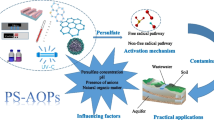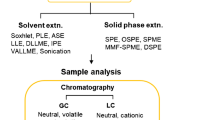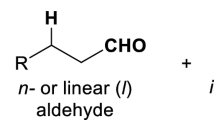Abstract
The autoxidation of 3,5-di-tert-butyl-4-hydroxytoluene (BHT, 1) in bar soap was investigated with ionspray tandem mass spectrometric and on-line gas chromatographic/mass spectrometric methods. The oxidation products of BHT were extracted from the bar soap surface, concentrated, and fractionated with open-column chromatography to remove the impurities. New oxidation products of BHT (BHT phenol-type dimer 7 and others) were identified with the two mass spectrometric methods. The results suggested that oxidation of BHT in bar soap occurred in a way different from that in the previous studies. In the new pathway, oxidation of BHT first generates an excited state of phenol-type dimer 4, and then this species decomposes, due to its high energy, to form dimer 7. The mechanism of oxidation is discussed.
Similar content being viewed by others
References
Squirrel, D.C.M., Analysis of Additives and Process Residues in Plastics Materials. Analyst 106:1042–1056 (1981).
Folley, L., and F.M. Kimmerle, Pulse Voltammetric Determination of Butylated Hydroxy Toluene in Transformer Oils. Anal. Chem. 51:818–822 (1979).
Bromberg, A., and K.A. Muszkat. Oxidation of 4a,4b-Dihydrophenanthrenes. I. Kinetics of the Thermal Reaction of 9,10-Cyclopentano-4a,4b-dihydrophenanthrene with Oxygen, J. Am. Chem. Soc. 91:2860–2866 (1969).
Thompson, D.C., Y.N. Cha, and M.A. Trush, The Peroxidase-Dependent Activation of Butylated Hydroxyanisole and Butylated Hydroxytoluene (BHT) to Reactive Intermediates, J. Biol. Chem. 264:3957–3965 (1989).
Maumy, M., and P. Capdevielle, Chemical Evidence for Peroxy Radicals Intermediacy in Copper (II) Reaction with Hydroperoxides, Tetrahedron 19:7455–7462 (1993).
Pokorny, J., Autoxidation of Unsaturated Lipids, edited by H.W.-S. Chan, Academic Press Inc. (London) Ltd., 1987, p. 169.
Bolton, J.L., Oxidation of Butylated Hydroxytoluene to Toxic Metabolites, Drug Metab. Dispos. 19:467–472 (1991).
Bolton, J.L., Formation and Reactivity of Alternative Quinone Methides from Butylated Hydroxytoluene: Possible Explanation for Species-Specific Pneumotoxicity, Chem. Res. Toxicol. 3:65–70 (1990).
Kurechi, T., and T. Kato, Study on the Antioxidants: XI. Oxidation Products of Concomitantly Used Butylated Hydroxyanisole and Butylated Hydroxytoluene, J. Am. Oil Chem. Soc. 57:220–223 (1980).
Spitz, H.D., Determination of 2,6-Di-(tert-butyl)-4-methylphenol in Rubber-Base Materials and Identification of an Oxidation Product from 2,6-Di-(tert-butyl)-4-methylphenol, J. Chromatogr. 190:193–196 (1980).
Majcherczyk, C., P. Polge, D. Baylocq, and F. Pellerin, Action des Rayonnements beta et des Oxydants sur le Di-tert-butyl-3,5 hydroxy-4 toluene, Talanta 33:985–989 (1986).
Segarra, V., F. Carrera, J.L. Fabregas, and J. Claramunt, Degradation Profile and Identification of the Major Degradation Products of Dobupride Under Several Conditions by GC/MS and HPLC-Particle Beam/MS, J. Pharm. Biomed. Anal. 13:987–993 (1995).
Schiavi, M., S. Serafini, A. Italia, M. Villa, G. Fronza, and A. Selva, Identification of the Major Degradation Products of 4-Methoxy-2-(3-phenyl-2-propynyl)phenol Formed by Exposure to Air and Light, J. Pharm. Sci. 81:812–814 (1992).
Jedlitschky, G., M. Huber, A. Volkl, M. Muller, I. Leider, J. Muller, W.D. Lehmann, H.D. Fahimi, and D. Keppler, Peroxisomal Degradation of Leukotrienes by β-Oxidation from the ω-End, J. Biol. Chem. 266:24763–24772 (1991).
Poon, G.K., Y.C. Chui, G.M.F. Bisset, and M. Jarman, Analysis of Anti-Cancer Drugs by Electrospray Ionization Mass Spectrometry, Proceedings of the Kyoto 92 International Conference on Biological Mass Spectrometry, edited by T. Matsuo, San-ei Publishing Co., Kyoto, Japan, 1992, pp. 396–397.
van Breemen, R.B., C.-R. Huang, Z.Z. Lu, A. Rimando, H.H.S. Fong, and J.F. Fitzloff, Electrospray Liquid Chromatography/Mass Spectrometry of Ginsenosides, Anal. Chem. 67:3985–3989 (1995).
Taylor, L.C.E., R. Singh, S.Y. Chang, and R.L. Johnson, The Identification of in vitro Metabolites of Bupropion Using Ion Trap Mass Spectrometry, Rapid Comm. Mass Spectrom. 9:902–910 (1995).
McLafferty, F.W., and F. Turecek, Interpretation of Mass Spectra, 4th edn., University Science Books, Sausalito, 1993, pp. 72.
Morrison, R.T., and R.N. Boyd, Organic Chemistry. 6th edn., Prentice Hall, Englewood Cliffs, 1992, p. 47.
Lide, D.R., CRC Handbook of Chemistry and Physics, 73rd edn., CRC Press, Boca Raton, 1992, pp. 9–14.
Author information
Authors and Affiliations
Corresponding author
About this article
Cite this article
Zhang, N., Kawakami, S., Higaki, M. et al. New oxidation pathway of 3,5-di-tert-butyl-4-hydroxytoluene: An ionspray tandem mass spectrometric and gas chromatographic/mass spectrometric study. J Amer Oil Chem Soc 74, 781–786 (1997). https://doi.org/10.1007/s11746-997-0218-6
Received:
Accepted:
Issue Date:
DOI: https://doi.org/10.1007/s11746-997-0218-6




